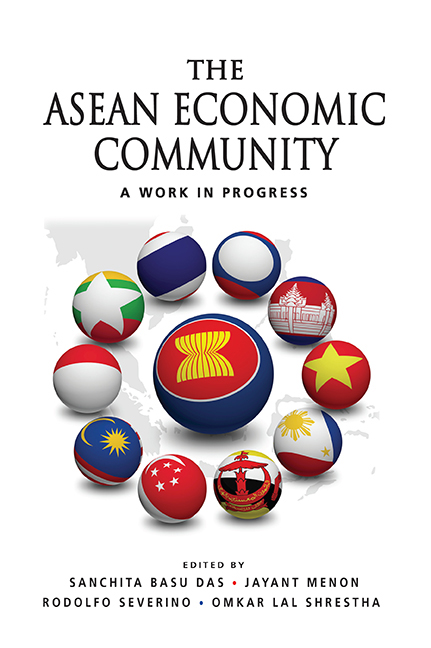Book contents
- Frontmatter
- Contents
- Foreword
- Foreword
- Preface
- acknowledgments
- Abbreviations
- The Contributors
- 1 Overview
- 2 Non-Tariff Barriers: A Challenge to Achieving the ASEAN Economic Community
- 3 ASEAN Trade in Services
- 4 The Asean Economic Community: The Investment Climate
- 5 Competition and Intellectual Property Laws in the ASEAN ‘Single Market’
- 6 Subregional Zones and ASEAN Economic Community
- 7 ASEAN FTAs: State of Play and Outlook for Asean's Regional and Global Integration
- 8 The Asean Dispute Settlement System
- 9 Enhancing the Institutional Framework for AEC Implementation: Designing Institutions that are Effective and Politically Feasible
- 10 ASEAN Economic Community Business Survey
- Index
6 - Subregional Zones and ASEAN Economic Community
Published online by Cambridge University Press: 21 October 2015
- Frontmatter
- Contents
- Foreword
- Foreword
- Preface
- acknowledgments
- Abbreviations
- The Contributors
- 1 Overview
- 2 Non-Tariff Barriers: A Challenge to Achieving the ASEAN Economic Community
- 3 ASEAN Trade in Services
- 4 The Asean Economic Community: The Investment Climate
- 5 Competition and Intellectual Property Laws in the ASEAN ‘Single Market’
- 6 Subregional Zones and ASEAN Economic Community
- 7 ASEAN FTAs: State of Play and Outlook for Asean's Regional and Global Integration
- 8 The Asean Dispute Settlement System
- 9 Enhancing the Institutional Framework for AEC Implementation: Designing Institutions that are Effective and Politically Feasible
- 10 ASEAN Economic Community Business Survey
- Index
Summary
ASEAN leaders have proclaimed their intention to create an ASEAN Economic Community (AEC) by 2015. The AEC, along with two other “pillars” — the ASEAN Security Community and the ASEAN Socio-cultural Community — make up the ASEAN Community, as declared in Bali Concord II of 2003. The last 5 years have witnessed various steps taken to speed up and strengthen community building: (a) bringing forward the date for meeting the goals of Vision 2020 to 2015, (b) ratifying the ASEAN Charter, (c) implementing the AEC Blueprint, and (d) adopting blueprints for the Socio-Cultural Community and the Political Security Community.
Yet, despite the various ASEAN initiatives toward economic integration, progress has been slow. Non-tariff barriers such as restrictive regulations and technical measures have not been removed. Negotiations to free up trade in services need to be accelerated. Thus, although ASEAN is a market of 600 million people, the region, in reality, remains a chain of disparate markets. Intra-regional trade currently makes up only about one-quarter of ASEAN's total trade volume, compared to more than 70% in the European Union. More importantly, a wide economic disparity divides the ASEAN–6 (Malaysia, Indonesia, Singapore, Thailand, Brunei Darussalam and the Philippines) from its four newer members (Cambodia, Lao PDR, Myanmar, and Viet Nam), which is a major hindrance to economic integration.
To address the issue of the economic divide, there are several programs on “hard” and “soft” infrastructure being initiated at the regional and subregional levels. For example, the Initiative for ASEAN Integration (IAI) aims to narrow the divide within ASEAN and enhance ASEAN's competitiveness as a region. In 2010, ASEAN also came up with the Master Plan on ASEAN Connectivity, which identified strategies and specific actions to speed up regional connectivity in three areas: physical connectivity, institutional connectivity and people-to-people connectivity that is intended to help in bringing about a smoother flow of trade in goods, services, investment and people in the region. The subregional programs, like the Greater Mekong Subregion (GMS), the Indonesia-Malaysia-Thailand Growth Triangle (IMT-GT) and the Brunei Darussalam–Indonesia–Malaysia–The Philippines East ASEAN Growth Area (BIMP-EAGA), aim to strengthen economic linkages between member countries. They also promote the economic integration of the region; assist in the construction of physical linkages among countries; and promote the fairer utilization of limited resources in the subregion.
- Type
- Chapter
- Information
- The ASEAN Economic CommunityA Work in Progress, pp. 279 - 319Publisher: ISEAS–Yusof Ishak InstitutePrint publication year: 2013



